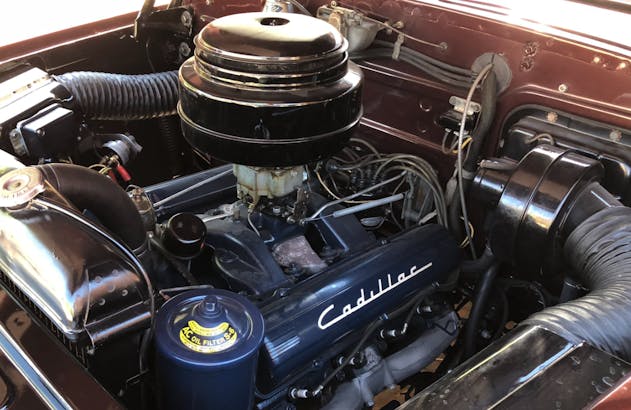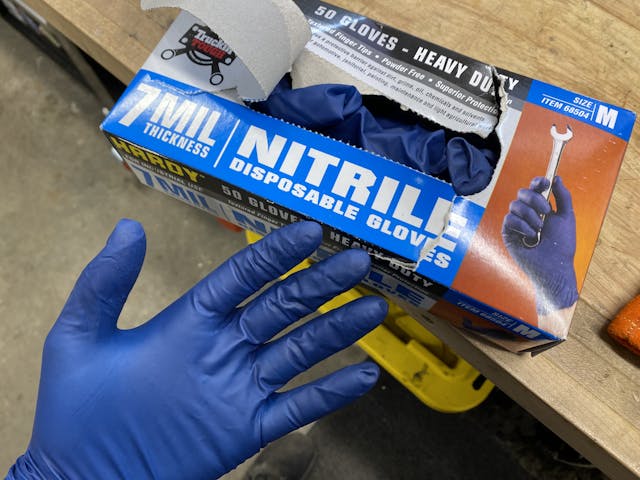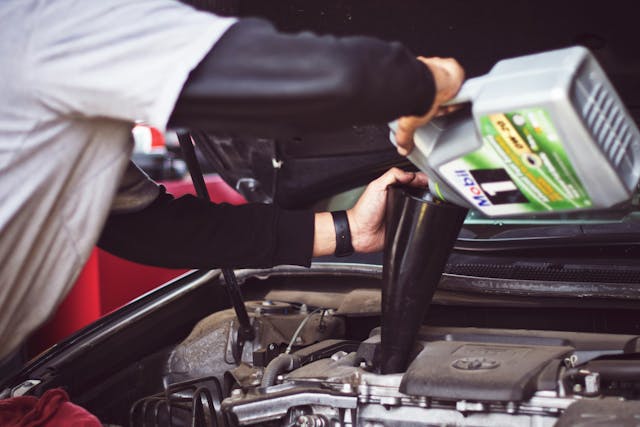8 oil change dos and don’ts
It’s a small job that somehow became a rite of passage for gearheads: Oil changes. The draining and refilling of engine oil is the first task that many budding wrench-turners undertake, and its certainly an important one. Like any other task in the automotive world, there are some pieces of institutional knowledge that comprise the key dos and don’ts for a smooth oil change. So let’s put these lessons learned out in the open, with the mission of shortening the process for newbies. And perhaps to reinforce some best practices for you veteran mechanics?
Don’t go crazy with warm-up

Modern oils are pretty amazing at suspending particles and contaminants, but there is still some junk that sinks down to the bottom of the pan. It needs to be stirred up to ensure it escapes when you pull the drain plug. Starting the engine and letting it idle for a minute or two is perfect for that final circulation. Run it any longer and you’re rewarded with nothing more than scalding hot oil that does nothing more than burn you. Before you pull that (drain) plug, give the engine a minute after shutting down, allowing the oil to drain to the pan from the nooks and crannies higher in the engine. But before you get underneath the vehicle to do the deed, remember you must…
Wear disposable gloves

Nitrile gloves keep you from soaking up solvents and oils into your skin. I’ve found 7mil thick to be a nice sweet spot of durable and affordable.
We all know the guy at the auto parts counter who has seriously gnarly hands from all the years being soaked in oil over decades of engine builds. That’s the visible damage. The invisible damage is sitting in your internal organs. All the hydrocarbons that get absorbed through the skin and are processed in our gut where they can’t be broken down. They end up accumulating in our body, which can cause serious health complications after years and years of chemical exposure. Preventing those issues is easy as putting on a pair of nitrile gloves. Use them even if it’s only for pulling the filter and drain plug, which you can do efficiently with…
The drain plug trick

It’s not groundbreaking, but nothing feels better than the perfect pull on a drain plug to ensure you don’t get any oil on your hand. The trick is pressure, not pulling. As you unthread the plug by hand, push in–against the bolt as in comes out–so the threads act as a seal with the outer edge. With a little practice you can get the pressure right (while not rocking the plug in the threads) and can spin the plug a full turn to feel for the “click.” That click means the bolt overlapped the last thread. With a swift motion away from the direction of oil flow, remove that now-loose plug. Presto! This can make thin viscosity oil changes much cleaner, and thick stuff like 20-50 can sometimes be spotless. In your excitement of not having a mess to clean up after draining, make sure you…
Don’t over tighten the drain plug or filter

It’s come to the point where stuck filters and stripped drain plugs are no longer a joke. Neither the filter nor plug require any real torque when installed properly. Use a small amount of oil to lube the filter’s rubber seal, then spin it into place. After the gasket seats on the housing, turn it only about three-quarter of an additional turn. Some applications might call for a full turn, but that is usually reserved for heavy duty equipment. Any tighter than what the filter manufacturers call for and you run the risk of deforming that rubber seal, which could cause oil to leak past the seal. That’s bad news. Any oil spillage is bad, so when you are filling…
Just use a funnel

The oil fill port on most engines is in that perfect spot where it looks like you could pour directly into it, except that’s a lie. They seem to be ideally located, but cleaning up if you miss (by even the smallest margin) can be a major pain. Are we really going to work so hard to spot and address leaks, to keep our engines clean, and just ruin it while doing routine maintenance?
I’m not. A funnel all but guarantees I won’t have to do any clean up after filling, even if I’m distracted or letting my 7 year-old niece do the filling. Putting in that fresh oil feels good, but be careful and…
Don’t overfill

This shows the rotating assembly without the oil pan and it’s easy to tell how oil at too high of a level would be bad.
Too much oil is just as bad as not enough. Seriously. The oil level in a wet-sump engine is carefully calculated to keep the rotating assembly from whipping through the oil. That action causes foaming, and oil foam pushed through the oiling system is the same as not having oil at all. I don’t need to tell you how bad that can be, so check the service or owners manual for the proper fill level. When done, look at the dipstick as a double check. Luckily, the empty oil containers you now have at this point are are perfect to…
Recycle your used oil

It’s never been easier to properly recycle used oil, so there is no excuse to do otherwise. Just about any auto parts store takes it, so they should be your first trip in your freshly serviced vehicle to “return” your oil. Be sure to capture oil in a non-contaminated pan so that the oil can actually be recycled. Coolant is the main enemy here, so be sure to flush your drain pan before the oil change. Luckily you don’t have to worry about how dusty or dirty the pan is, but other fluids can defeat the purpose of recycling. But before you make the trip to recycle the oil, be sure to…
Reset the computer (or write down your service date)

Modern cars have an oil life monitoring system. Whether you trust it is a personal preference, but for the sake of eliminating confusion, go ahead and reset it now. Most reset procedures involves cycling the ignition key and pressing the throttle pedal a certain number of times. The service manual will outline it, or a quick search to an online make/model specific forum will have the instructions. If your vehicles are of the manual variety, write down the oil change date in a log book. Or consider service tracker kept in the car or garage, as it keeps you from forgetting what’s been done. Not to mention thisa paper trail shows good stewardship to a potential next owner, which can mean an easier sale for more money.
In all, oil changes can be simple and rewarding for newbies and DIY enthusiasts alike. Following these best practices will not only keep your vehicle happy, but also make the experience better for you each time. Do you have something specific you add to this process? Let us know about it in the comments below.
***
Check out the Hagerty Media homepage so you don’t miss a single story, or better yet, bookmark it. To get our best stories delivered right to your inbox, subscribe to our newsletters.



While you are under the hood, check your blinker fluid.
And don’t forget the muffler bearings
There is nothing wrong with the advice of following the manufacturers recommendations when you have a fairly new car made after oil technology reached it present stage. You have to have knowledge of your cars lubrication system when your car is an older classic or collectable. Porsche recommended every 1,500 miles for my 62 year old Porsche. That was based on oil technology 61 years ago. Using modern synthetic oil changes, that picture has changed and leaves the owner in a bit of a quandary. First off the car does not have a full flow oil filter. It is a by pass system wherein only about 8% of the oil is filtered. The original oil filter functions better as an oil cooler. 10,000 mile changes are out the window, 1,500 mile changes seem excessive. If you drive 1-2 thousand miles a year then once a year seems logical and necessary. I guess it all comes down to picking a conservative cautious interval depending on whether your car even has an oil filter, if so, how effective is it, are you using synthetic oil and your driving habits. Kudos to Porsche a few years ago they came out with new recommendation for their air cooled engines. Rather than the original single weight oil depending on temperature, they now recommend 20-50 for my car which they sell at the dealership. It is not synthetic. Don’t know if they are saying don’t use synthetic or saying mineral oil works just fine so buy it from us at synthetic prices.
One very important thing missed here.
MAKE SURE OLD OIL FILTER GASKET IS NOT STUCK TO FILTER MOUNTIG SURFACE.
If it is, you will know soon after starting engine after oil change. It wil be leaking profusely
I did not see this in the comments, but I also use a marker and put Millage and date on the filter. So if someone else gets the car they know for sure when it was last done.
WOW, 13 pages of comments.
Newer motors are built with much tighter tolerances everywhere, hince the thinner oil specifications. The tighter clearances also reduce blowby substantually so oil will get much less comtaminents and both oil and filter will stay cleaner longer. That’s why it’s rare to have to rebuild a newer motor like we did about every 100k miles in the ’60s. And that’s agood thing.
The hazard of the old filter seal being left on the block seems very common. This happened to an acquaintance who had it done at a quick change place.
A cool item that I saw recently was little oil change stickers that you can customize, even with pictures of your car and a fun motto. Makes a nice gift. Saw them on Amazon for under ten bucks.
No need to wait a minute for oil to drain back into the pan before pulling the plug, just let it drain fully til just a drip every few seconds.
Wipe the plug threads with clean rag
Wipe the oil filter mounting surface clean while checking to make sure the old gasket isn’t still there.
My daughter and her BF, both recent college (engineering) grads, change their own oil. It’s one of those little things in my life that gives me hope for the country’s future.
I like LoydT,s advice about writing down the wrench size for the plug. I have 4 vehicles and many times I have brought the wrong wrench under the car and found it didn’t fit. Thanks Loyd. Dunh! What a dummy I am sometimes.👍😆
Hi Scotty, I like to see you fill the filter with oil on the engine shown in Kyles introduction pictures. It goes in horizontally. My car’s filter is on an steep angle, also impossible.
Make sure to use the manufacturer’s recommended oil viscosity grade!
One last comment. Buy a brand name filter. My son complained that his 289 engine had a slight rod knock for a few seconds each time he started it. He had changed the oil recently and then the rod knock started. I checked it out and seen that he had bought a cheap oil filter. We changed it and the noise disappeared. Filters have a check valve in them to keep oil from draining out of them. That filter was junk. Spend some money on a good filter.
Good thoughts. For a few bucks difference seems to me its worth the insurance to have the right filter
I have taken the wooden ramps to the extreme. They are now 12 inches wide and 12 inches high and 14 feet long. I park on these beams , exclusively. Never have to jack the car up for anything or worry about it falling off jack stands. Perfect for a pro- street car that’s too low to even get a jack under
Maybe already said but the electronic counters are a PITA. On our 2020 GLC 300 you got to hold your nose to the left, or the right if its the third Wednesday in May, select the maint icon, yell hey honey get me a beer, decide what kind of oil you added, do three finger snaps, confirm your twelve choices, then go try to find the notes you scribbled down last time you were successful for the reset. I got to believe there are a couple German engineers thinking…. They may have won the war, but we will show them.